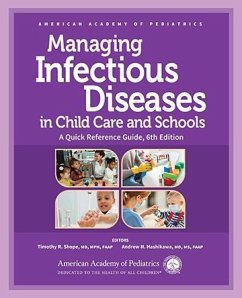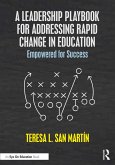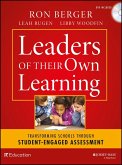Managing Infectious Diseases in Child Care and Schools (eBook, PDF)
Redaktion: Shope, Timothy R.; Hashikawa, Andrew N.
57,95 €
57,95 €
inkl. MwSt.
Sofort per Download lieferbar

29 °P sammeln
57,95 €
Als Download kaufen

57,95 €
inkl. MwSt.
Sofort per Download lieferbar

29 °P sammeln
Jetzt verschenken
Alle Infos zum eBook verschenken
57,95 €
inkl. MwSt.
Sofort per Download lieferbar
Alle Infos zum eBook verschenken

29 °P sammeln
Managing Infectious Diseases in Child Care and Schools (eBook, PDF)
Redaktion: Shope, Timothy R.; Hashikawa, Andrew N.
- Format: PDF
- Merkliste
- Auf die Merkliste
- Bewerten Bewerten
- Teilen
- Produkt teilen
- Produkterinnerung
- Produkterinnerung

Bitte loggen Sie sich zunächst in Ihr Kundenkonto ein oder registrieren Sie sich bei
bücher.de, um das eBook-Abo tolino select nutzen zu können.
Hier können Sie sich einloggen
Hier können Sie sich einloggen
Sie sind bereits eingeloggt. Klicken Sie auf 2. tolino select Abo, um fortzufahren.

Bitte loggen Sie sich zunächst in Ihr Kundenkonto ein oder registrieren Sie sich bei bücher.de, um das eBook-Abo tolino select nutzen zu können.
This guide provides child care directors, teachers, and caregivers with essential information on infectious diseases in group care settings. It includes a robust section of more than 55 quick reference fact sheets on common infectious diseases and symptoms. Additionally, it includes forms that can be photocopied and used with families. As always, the reference is easy to use, providing clear, authoritative information on infectious diseases.
- Geräte: PC
- mit Kopierschutz
- eBook Hilfe
- Größe: 21.14MB
- FamilySharing(5)
Andere Kunden interessierten sich auch für
![Improving Teacher Morale and Motivation (eBook, PDF) Improving Teacher Morale and Motivation (eBook, PDF)]() Ronald WilliamsonImproving Teacher Morale and Motivation (eBook, PDF)28,95 €
Ronald WilliamsonImproving Teacher Morale and Motivation (eBook, PDF)28,95 €![A Leadership Playbook for Addressing Rapid Change in Education (eBook, PDF) A Leadership Playbook for Addressing Rapid Change in Education (eBook, PDF)]() Teresa L. San MartinA Leadership Playbook for Addressing Rapid Change in Education (eBook, PDF)27,95 €
Teresa L. San MartinA Leadership Playbook for Addressing Rapid Change in Education (eBook, PDF)27,95 €![The Gender Equation in Schools (eBook, PDF) The Gender Equation in Schools (eBook, PDF)]() Jason AblinThe Gender Equation in Schools (eBook, PDF)25,95 €
Jason AblinThe Gender Equation in Schools (eBook, PDF)25,95 €![Leading Continuous Improvement in Schools (eBook, PDF) Leading Continuous Improvement in Schools (eBook, PDF)]() Erin AndersonLeading Continuous Improvement in Schools (eBook, PDF)41,95 €
Erin AndersonLeading Continuous Improvement in Schools (eBook, PDF)41,95 €![When Schools Compete (eBook, PDF) When Schools Compete (eBook, PDF)]() Edward B. FiskeWhen Schools Compete (eBook, PDF)16,95 €
Edward B. FiskeWhen Schools Compete (eBook, PDF)16,95 €![Leaders of Their Own Learning (eBook, PDF) Leaders of Their Own Learning (eBook, PDF)]() Ron BergerLeaders of Their Own Learning (eBook, PDF)21,99 €
Ron BergerLeaders of Their Own Learning (eBook, PDF)21,99 €![Stand Tall Leadership (eBook, PDF) Stand Tall Leadership (eBook, PDF)]() Steven A. BollarStand Tall Leadership (eBook, PDF)20,99 €
Steven A. BollarStand Tall Leadership (eBook, PDF)20,99 €-
-
-
This guide provides child care directors, teachers, and caregivers with essential information on infectious diseases in group care settings. It includes a robust section of more than 55 quick reference fact sheets on common infectious diseases and symptoms. Additionally, it includes forms that can be photocopied and used with families. As always, the reference is easy to use, providing clear, authoritative information on infectious diseases.
Produktdetails
- Produktdetails
- Verlag: American Academy of Pediatrics
- Seitenzahl: 271
- Erscheinungstermin: 15. März 2023
- Englisch
- ISBN-13: 9781610026604
- Artikelnr.: 68956016
- Verlag: American Academy of Pediatrics
- Seitenzahl: 271
- Erscheinungstermin: 15. März 2023
- Englisch
- ISBN-13: 9781610026604
- Artikelnr.: 68956016
- Herstellerkennzeichnung Die Herstellerinformationen sind derzeit nicht verfügbar.
Timothy R. Shope, MD, MPH, FAAP, is an academic general pediatrician and professor of pediatrics at UPMC Children’s Hospital of Pittsburgh. Dr Shope has over 30 years of experience consulting with early childhood educational programs and schools, the Department of Defense, and state policymakers on the topic of managing infectious diseases. He speaks regularly at national meetings and webinars and contributes to many publications on the subject. Dr Shope is a member of the American Academy of Pediatrics Council on Early Childhood. Andrew N. Hashikawa, MD, MS, FAAP, is a pediatric emergency medicine (PEM) physician and associate professor at the University of Michigan. He serves as a volunteer child care health consultant for local child care centers. He earned his medical degree and completed a pediatric residency at the Mayo Clinic. He then completed a PEM fellowship and a master’s degree in epidemiology at the Medical College of Wisconsin. Dr Hashikawa has served as the American Academy of Pediatrics (AAP) Michigan Early Childhood Champion for over a decade. He has helped create training content on injury prevention and medication administration for child care providers on the AAP e-learning platform Pedialink. He is an executive committee member of the AAP Council on Early Childhood. Dr. Hashikawa has published extensively in child care research related to health and safety. He created MCRISP (Michigan Child Care Related Surveillance Program) to assist child care centers in reporting illnesses to the local public health department. He received the Head Start 50th Anniversary Award in 2015, and in 2019, he received the AAP Council on Early Childhood Dr Susan S. Aronson Early Education and Child Advocacy Award for making a significant contribution to improving the health, safety, and development of children in early education and child care settings. Dr Hashikawa resides near Ann Arbor with his wife and 3 teenage daughters.
Preface
About This Book
What Is New in This Edition?
Chapter 1 Overview of Managing Infectious Diseases in Child Care and
Schools
* Introduction
* Keeping Children and Adults in Group Settings Healthy
* Roles of Families, Staff Members, and Health Professionals in
Managing Infectious Diseases for Children Enrolled in Early Education
and Child Care
* Planning and Policies
Chapter 2 Reduce the Risk of Infection: Practice Prevention
* Safe Food Preparation and Service
* Hand Hygiene
* Changing Diapers, Soiled Disposable Training Pants, and Soiled
Underwear
* Preventive Oral Health
* Standard Precautions
* Sanitation, Disinfection, and Maintenance
* Heating, Ventilation, and Air-conditioning
Chapter 3 Health of Teachers, Caregivers, and Other Staff Members
* Introduction
* Preemployment Requirements and Ongoing Adult Health Appraisals and
Immunizations
* Immunization With Recommended Vaccines
* Oral Health Practices in Early Childhood Education Settings
* Health Limitations for Staff Members
* Policies and Procedures Related to Caring for Staff and Children Who
Are Ill
* Staff Learn, Teach, and Practice Minimizing Infectious Diseases
Chapter 4 Recognizing the Ill Child: Inclusion/Exclusion Criteria
* Daily Health Check
* Elements to Observe and Information to Gather
* Situations That Require Medical Attention Right Away
* Conditions That Do Not Require Exclusion to Control Spread of Disease
to Others
* Conditions Requiring Temporary Exclusion
* Procedures for a Child Who Requires Exclusion
* Reportable/Notifiable Conditions
* Preparing for Managing Illness
Chapter 5 Signs and Symptoms Chart
Chapter 6 Quick Reference Sheets
* Bedbugs
* Bites (Human and Animal)
* Boil/Abscess/Cellulitis
* Campylobacter
* Chickenpox (Varicella-Zoster Infections)
* Clostridium difficile (Also Called “C diff”)
* COVID-19
* Croup
* Cryptosporidiosis
* Cytomegalovirus (CMV) Infection
* Dental Caries (Early Childhood Caries, Tooth Decay, or Cavities)
* Diaper Rash
* Diarrhea
* Diarrhea Caused by Specific Types of E coli (Escherichia coli)
* Ear Infection
* Fever
* Fifth Disease (Human Parvovirus B19)
* Giardiasis
* Haemophilus influenzae Type b (Hib)
* Hand-Foot-and-Mouth Disease
* Hepatitis A Infection
* Hepatitis B Infection
* Herpes Simplex (Cold Sores)
* HIV/AIDS
* Impetigo
* Influenza
* Lice (Pediculosis Capitis)
* Lyme Disease (and Other Tick-borne Diseases)
* Measles
* Meningitis
* Molluscum Contagiosum
* Mononucleosis
* Mosquito-borne Diseases
* Mouth Sores
* Mumps
* Norovirus
* Pinkeye (Conjunctivitis)
* Pinworms
* Pneumonia
* Respiratory Syncytial Virus (RSV)
* Ringworm
* Roseola (Human Herpesvirus 6 and 7)
* Rotavirus
* Rubella (German Measles)
* Salmonella
* Scabies
* Shigella
* Shingles (Herpes Zoster)
* Staphylococcus aureus (Methicillin-Resistant [MRSA] and
Methicillin-Sensitive [MSSA])
* Strep Throat (Streptococcal Pharyngitis) and Scarlet Fever
* Sty
* Thrush (Candidiasis)
* Tuberculosis (TB)
* Upper Respiratory Infection (Common Cold)
* Urinary Tract Infection
* Vomiting
* Warts (Human Papillomavirus)
* Whooping Cough (Pertussis)
Chapter 7 Infectious Disease Outbreaks, Epidemics, Pandemics, and
Bioterrorism
* Why Children Are Especially Vulnerable
* Planning
* Types of Infectious Disease Emergencies
* Closure of Group Care Facilities
* Quick Communication and Initiation of Emergency Procedures
* Symptom Records
* Parent/Legal Guardian Notification
* Tracking Procedure
* Corrective Action
Chapter 8 Sample Letters, Forms, and Relevant Resources
* Child Health Assessment Form
* Special Care Plan Form
* Medication Administration Packet
* Letter to Staff About Occupational Health Risks
* Refusal to Vaccinate Form
* Staff Health Assessment Form
* Routine Schedule for Cleaning, Sanitizing, and Disinfecting
* Selecting an Appropriate Sanitizer or Disinfectant
* Cleaning Up Body Fluids
* Sample Health Information Consent Form
* Sample Food Service Cleaning Schedule
* Diapering Poster
* Gloving
* Infections Caused by Interactions of Humans With Pets and Wild
Animals
* Symptom Record Form
* Enrollment/Attendance/Symptom Record
* Situations That Require Medical Attention Right Away
* Sample Letter to Families About Exposure to Communicable Disease
Glossary
Index
About This Book
What Is New in This Edition?
Chapter 1 Overview of Managing Infectious Diseases in Child Care and
Schools
* Introduction
* Keeping Children and Adults in Group Settings Healthy
* Roles of Families, Staff Members, and Health Professionals in
Managing Infectious Diseases for Children Enrolled in Early Education
and Child Care
* Planning and Policies
Chapter 2 Reduce the Risk of Infection: Practice Prevention
* Safe Food Preparation and Service
* Hand Hygiene
* Changing Diapers, Soiled Disposable Training Pants, and Soiled
Underwear
* Preventive Oral Health
* Standard Precautions
* Sanitation, Disinfection, and Maintenance
* Heating, Ventilation, and Air-conditioning
Chapter 3 Health of Teachers, Caregivers, and Other Staff Members
* Introduction
* Preemployment Requirements and Ongoing Adult Health Appraisals and
Immunizations
* Immunization With Recommended Vaccines
* Oral Health Practices in Early Childhood Education Settings
* Health Limitations for Staff Members
* Policies and Procedures Related to Caring for Staff and Children Who
Are Ill
* Staff Learn, Teach, and Practice Minimizing Infectious Diseases
Chapter 4 Recognizing the Ill Child: Inclusion/Exclusion Criteria
* Daily Health Check
* Elements to Observe and Information to Gather
* Situations That Require Medical Attention Right Away
* Conditions That Do Not Require Exclusion to Control Spread of Disease
to Others
* Conditions Requiring Temporary Exclusion
* Procedures for a Child Who Requires Exclusion
* Reportable/Notifiable Conditions
* Preparing for Managing Illness
Chapter 5 Signs and Symptoms Chart
Chapter 6 Quick Reference Sheets
* Bedbugs
* Bites (Human and Animal)
* Boil/Abscess/Cellulitis
* Campylobacter
* Chickenpox (Varicella-Zoster Infections)
* Clostridium difficile (Also Called “C diff”)
* COVID-19
* Croup
* Cryptosporidiosis
* Cytomegalovirus (CMV) Infection
* Dental Caries (Early Childhood Caries, Tooth Decay, or Cavities)
* Diaper Rash
* Diarrhea
* Diarrhea Caused by Specific Types of E coli (Escherichia coli)
* Ear Infection
* Fever
* Fifth Disease (Human Parvovirus B19)
* Giardiasis
* Haemophilus influenzae Type b (Hib)
* Hand-Foot-and-Mouth Disease
* Hepatitis A Infection
* Hepatitis B Infection
* Herpes Simplex (Cold Sores)
* HIV/AIDS
* Impetigo
* Influenza
* Lice (Pediculosis Capitis)
* Lyme Disease (and Other Tick-borne Diseases)
* Measles
* Meningitis
* Molluscum Contagiosum
* Mononucleosis
* Mosquito-borne Diseases
* Mouth Sores
* Mumps
* Norovirus
* Pinkeye (Conjunctivitis)
* Pinworms
* Pneumonia
* Respiratory Syncytial Virus (RSV)
* Ringworm
* Roseola (Human Herpesvirus 6 and 7)
* Rotavirus
* Rubella (German Measles)
* Salmonella
* Scabies
* Shigella
* Shingles (Herpes Zoster)
* Staphylococcus aureus (Methicillin-Resistant [MRSA] and
Methicillin-Sensitive [MSSA])
* Strep Throat (Streptococcal Pharyngitis) and Scarlet Fever
* Sty
* Thrush (Candidiasis)
* Tuberculosis (TB)
* Upper Respiratory Infection (Common Cold)
* Urinary Tract Infection
* Vomiting
* Warts (Human Papillomavirus)
* Whooping Cough (Pertussis)
Chapter 7 Infectious Disease Outbreaks, Epidemics, Pandemics, and
Bioterrorism
* Why Children Are Especially Vulnerable
* Planning
* Types of Infectious Disease Emergencies
* Closure of Group Care Facilities
* Quick Communication and Initiation of Emergency Procedures
* Symptom Records
* Parent/Legal Guardian Notification
* Tracking Procedure
* Corrective Action
Chapter 8 Sample Letters, Forms, and Relevant Resources
* Child Health Assessment Form
* Special Care Plan Form
* Medication Administration Packet
* Letter to Staff About Occupational Health Risks
* Refusal to Vaccinate Form
* Staff Health Assessment Form
* Routine Schedule for Cleaning, Sanitizing, and Disinfecting
* Selecting an Appropriate Sanitizer or Disinfectant
* Cleaning Up Body Fluids
* Sample Health Information Consent Form
* Sample Food Service Cleaning Schedule
* Diapering Poster
* Gloving
* Infections Caused by Interactions of Humans With Pets and Wild
Animals
* Symptom Record Form
* Enrollment/Attendance/Symptom Record
* Situations That Require Medical Attention Right Away
* Sample Letter to Families About Exposure to Communicable Disease
Glossary
Index
Preface
About This Book
What Is New in This Edition?
Chapter 1 Overview of Managing Infectious Diseases in Child Care and
Schools
* Introduction
* Keeping Children and Adults in Group Settings Healthy
* Roles of Families, Staff Members, and Health Professionals in
Managing Infectious Diseases for Children Enrolled in Early Education
and Child Care
* Planning and Policies
Chapter 2 Reduce the Risk of Infection: Practice Prevention
* Safe Food Preparation and Service
* Hand Hygiene
* Changing Diapers, Soiled Disposable Training Pants, and Soiled
Underwear
* Preventive Oral Health
* Standard Precautions
* Sanitation, Disinfection, and Maintenance
* Heating, Ventilation, and Air-conditioning
Chapter 3 Health of Teachers, Caregivers, and Other Staff Members
* Introduction
* Preemployment Requirements and Ongoing Adult Health Appraisals and
Immunizations
* Immunization With Recommended Vaccines
* Oral Health Practices in Early Childhood Education Settings
* Health Limitations for Staff Members
* Policies and Procedures Related to Caring for Staff and Children Who
Are Ill
* Staff Learn, Teach, and Practice Minimizing Infectious Diseases
Chapter 4 Recognizing the Ill Child: Inclusion/Exclusion Criteria
* Daily Health Check
* Elements to Observe and Information to Gather
* Situations That Require Medical Attention Right Away
* Conditions That Do Not Require Exclusion to Control Spread of Disease
to Others
* Conditions Requiring Temporary Exclusion
* Procedures for a Child Who Requires Exclusion
* Reportable/Notifiable Conditions
* Preparing for Managing Illness
Chapter 5 Signs and Symptoms Chart
Chapter 6 Quick Reference Sheets
* Bedbugs
* Bites (Human and Animal)
* Boil/Abscess/Cellulitis
* Campylobacter
* Chickenpox (Varicella-Zoster Infections)
* Clostridium difficile (Also Called “C diff”)
* COVID-19
* Croup
* Cryptosporidiosis
* Cytomegalovirus (CMV) Infection
* Dental Caries (Early Childhood Caries, Tooth Decay, or Cavities)
* Diaper Rash
* Diarrhea
* Diarrhea Caused by Specific Types of E coli (Escherichia coli)
* Ear Infection
* Fever
* Fifth Disease (Human Parvovirus B19)
* Giardiasis
* Haemophilus influenzae Type b (Hib)
* Hand-Foot-and-Mouth Disease
* Hepatitis A Infection
* Hepatitis B Infection
* Herpes Simplex (Cold Sores)
* HIV/AIDS
* Impetigo
* Influenza
* Lice (Pediculosis Capitis)
* Lyme Disease (and Other Tick-borne Diseases)
* Measles
* Meningitis
* Molluscum Contagiosum
* Mononucleosis
* Mosquito-borne Diseases
* Mouth Sores
* Mumps
* Norovirus
* Pinkeye (Conjunctivitis)
* Pinworms
* Pneumonia
* Respiratory Syncytial Virus (RSV)
* Ringworm
* Roseola (Human Herpesvirus 6 and 7)
* Rotavirus
* Rubella (German Measles)
* Salmonella
* Scabies
* Shigella
* Shingles (Herpes Zoster)
* Staphylococcus aureus (Methicillin-Resistant [MRSA] and
Methicillin-Sensitive [MSSA])
* Strep Throat (Streptococcal Pharyngitis) and Scarlet Fever
* Sty
* Thrush (Candidiasis)
* Tuberculosis (TB)
* Upper Respiratory Infection (Common Cold)
* Urinary Tract Infection
* Vomiting
* Warts (Human Papillomavirus)
* Whooping Cough (Pertussis)
Chapter 7 Infectious Disease Outbreaks, Epidemics, Pandemics, and
Bioterrorism
* Why Children Are Especially Vulnerable
* Planning
* Types of Infectious Disease Emergencies
* Closure of Group Care Facilities
* Quick Communication and Initiation of Emergency Procedures
* Symptom Records
* Parent/Legal Guardian Notification
* Tracking Procedure
* Corrective Action
Chapter 8 Sample Letters, Forms, and Relevant Resources
* Child Health Assessment Form
* Special Care Plan Form
* Medication Administration Packet
* Letter to Staff About Occupational Health Risks
* Refusal to Vaccinate Form
* Staff Health Assessment Form
* Routine Schedule for Cleaning, Sanitizing, and Disinfecting
* Selecting an Appropriate Sanitizer or Disinfectant
* Cleaning Up Body Fluids
* Sample Health Information Consent Form
* Sample Food Service Cleaning Schedule
* Diapering Poster
* Gloving
* Infections Caused by Interactions of Humans With Pets and Wild
Animals
* Symptom Record Form
* Enrollment/Attendance/Symptom Record
* Situations That Require Medical Attention Right Away
* Sample Letter to Families About Exposure to Communicable Disease
Glossary
Index
About This Book
What Is New in This Edition?
Chapter 1 Overview of Managing Infectious Diseases in Child Care and
Schools
* Introduction
* Keeping Children and Adults in Group Settings Healthy
* Roles of Families, Staff Members, and Health Professionals in
Managing Infectious Diseases for Children Enrolled in Early Education
and Child Care
* Planning and Policies
Chapter 2 Reduce the Risk of Infection: Practice Prevention
* Safe Food Preparation and Service
* Hand Hygiene
* Changing Diapers, Soiled Disposable Training Pants, and Soiled
Underwear
* Preventive Oral Health
* Standard Precautions
* Sanitation, Disinfection, and Maintenance
* Heating, Ventilation, and Air-conditioning
Chapter 3 Health of Teachers, Caregivers, and Other Staff Members
* Introduction
* Preemployment Requirements and Ongoing Adult Health Appraisals and
Immunizations
* Immunization With Recommended Vaccines
* Oral Health Practices in Early Childhood Education Settings
* Health Limitations for Staff Members
* Policies and Procedures Related to Caring for Staff and Children Who
Are Ill
* Staff Learn, Teach, and Practice Minimizing Infectious Diseases
Chapter 4 Recognizing the Ill Child: Inclusion/Exclusion Criteria
* Daily Health Check
* Elements to Observe and Information to Gather
* Situations That Require Medical Attention Right Away
* Conditions That Do Not Require Exclusion to Control Spread of Disease
to Others
* Conditions Requiring Temporary Exclusion
* Procedures for a Child Who Requires Exclusion
* Reportable/Notifiable Conditions
* Preparing for Managing Illness
Chapter 5 Signs and Symptoms Chart
Chapter 6 Quick Reference Sheets
* Bedbugs
* Bites (Human and Animal)
* Boil/Abscess/Cellulitis
* Campylobacter
* Chickenpox (Varicella-Zoster Infections)
* Clostridium difficile (Also Called “C diff”)
* COVID-19
* Croup
* Cryptosporidiosis
* Cytomegalovirus (CMV) Infection
* Dental Caries (Early Childhood Caries, Tooth Decay, or Cavities)
* Diaper Rash
* Diarrhea
* Diarrhea Caused by Specific Types of E coli (Escherichia coli)
* Ear Infection
* Fever
* Fifth Disease (Human Parvovirus B19)
* Giardiasis
* Haemophilus influenzae Type b (Hib)
* Hand-Foot-and-Mouth Disease
* Hepatitis A Infection
* Hepatitis B Infection
* Herpes Simplex (Cold Sores)
* HIV/AIDS
* Impetigo
* Influenza
* Lice (Pediculosis Capitis)
* Lyme Disease (and Other Tick-borne Diseases)
* Measles
* Meningitis
* Molluscum Contagiosum
* Mononucleosis
* Mosquito-borne Diseases
* Mouth Sores
* Mumps
* Norovirus
* Pinkeye (Conjunctivitis)
* Pinworms
* Pneumonia
* Respiratory Syncytial Virus (RSV)
* Ringworm
* Roseola (Human Herpesvirus 6 and 7)
* Rotavirus
* Rubella (German Measles)
* Salmonella
* Scabies
* Shigella
* Shingles (Herpes Zoster)
* Staphylococcus aureus (Methicillin-Resistant [MRSA] and
Methicillin-Sensitive [MSSA])
* Strep Throat (Streptococcal Pharyngitis) and Scarlet Fever
* Sty
* Thrush (Candidiasis)
* Tuberculosis (TB)
* Upper Respiratory Infection (Common Cold)
* Urinary Tract Infection
* Vomiting
* Warts (Human Papillomavirus)
* Whooping Cough (Pertussis)
Chapter 7 Infectious Disease Outbreaks, Epidemics, Pandemics, and
Bioterrorism
* Why Children Are Especially Vulnerable
* Planning
* Types of Infectious Disease Emergencies
* Closure of Group Care Facilities
* Quick Communication and Initiation of Emergency Procedures
* Symptom Records
* Parent/Legal Guardian Notification
* Tracking Procedure
* Corrective Action
Chapter 8 Sample Letters, Forms, and Relevant Resources
* Child Health Assessment Form
* Special Care Plan Form
* Medication Administration Packet
* Letter to Staff About Occupational Health Risks
* Refusal to Vaccinate Form
* Staff Health Assessment Form
* Routine Schedule for Cleaning, Sanitizing, and Disinfecting
* Selecting an Appropriate Sanitizer or Disinfectant
* Cleaning Up Body Fluids
* Sample Health Information Consent Form
* Sample Food Service Cleaning Schedule
* Diapering Poster
* Gloving
* Infections Caused by Interactions of Humans With Pets and Wild
Animals
* Symptom Record Form
* Enrollment/Attendance/Symptom Record
* Situations That Require Medical Attention Right Away
* Sample Letter to Families About Exposure to Communicable Disease
Glossary
Index







